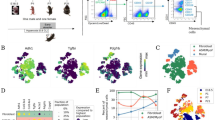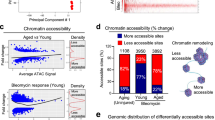Abstract
By providing insight into the cellular events of vascular injury and repair, experimental model systems seek to promote timely therapeutic strategies for human disease. The goal of many current studies of neovascularization is to identify cells critical to the process and their role in vascular channel assembly. We propose here a protocol to analyze, in an in vivo rodent model, vessel and capillary remodeling (reorganization and growth) in the injured lung. Sequential analyses of stages in the assembly of vascular structures, and of relevant cell types, provide further opportunities to study the molecular and cellular determinants of lung neovascularization.
This is a preview of subscription content, access via your institution
Access options
Subscribe to this journal
Receive 12 print issues and online access
$259.00 per year
only $21.58 per issue
Buy this article
- Purchase on Springer Link
- Instant access to full article PDF
Prices may be subject to local taxes which are calculated during checkout





Similar content being viewed by others
References
Jones, R.C. & Jacobson, M. Angiogenesis in the hypertensive lung: response to ambient oxygen tension. Cell Tissue Res. 300, 263–284 (2000).
Jones, R., Steudel, W., White, S., Jacobson, M. & Low, R. Microvessel precursor smooth muscle cells express head-inserted smooth muscle myosin heavy chain (SM-B) isoform in hyperoxic pulmonary hypertension. Cell Tissue Res. 295, 453–465 (1999).
Jones, R., Jacobson, M. & Steudel, W. alpha-smooth-muscle actin and microvascular precursor smooth-muscle cells in pulmonary hypertension. Am. J. Respir. Cell Mol. Biol. 20, 582–594 (1999).
Jones, R. Ultrastructural analysis of contractile cell development in lung microvessels in hyperoxic pulmonary hypertension. Fibroblasts and intermediate cells selectively reorganize nonmuscular segments. Am. J. Pathol. 141, 1491–1505 (1992).
Jones, R.C. et al. A protocol for phenotypic detection and characterization of vascular cells of different origins in a lung neovascularization model in rodents. Nat. Protoc. 3, 388–397 (2008).
Mitzner, W. & Wagner, E.M. Vascular remodeling in the circulations of the lung. J. Appl. Physiol. 97, 1999–2004 (2004).
Jones, R. & Reid, L. Vascular remodeling in clinical and experimental pulmonary hypertensions. in Pulmonary Vascular Remodeling 47–115 (Portland Press, London, 1995).
Frid, M.G. et al. Hypoxia-induced pulmonary vascular remodeling requires recruitment of circulating mesenchymal precursors of a monocyte/macrophage lineage. Am. J. Pathol. 168, 659–669 (2006).
Boxt, L.M. et al. Fractal analysis of pulmonary arteries: the fractal dimension is lower in pulmonary hypertension. J. Thorac. Imaging 9, 8–13 (1994).
Hu, L.M. & Jones, R. Injury and remodeling of pulmonary veins by high oxygen. A morphometric study. Am. J. Pathol. 134, 253–262 (1989).
Klekamp, J.G., Jarzecka, K. & Perkett, E.A. Exposure to hyperoxia decreases the expression of vascular endothelial growth factor and its receptors in adult rat lungs. Am. J. Pathol. 154, 823–831 (1999).
Maniscalco, W.M., Watkins, R.H., Finkelstein, J.N. & Campbell, M.H. Vascular endothelial growth factor mRNA increases in alveolar epithelial cells during recovery from oxygen injury. Am. J. Respir. Cell Mol. Biol. 13, 377–386 (1995).
Acknowledgements
Supported by NIH R01HL 070866 (to R.C.J.), NIH R01CA 115767 (to R.K.J.) and by a Career Development Award to D.G.D. (from the American Association for Cancer Research-Genentech BioOncology).
Author information
Authors and Affiliations
Corresponding author
Rights and permissions
About this article
Cite this article
Jones, R., Capen, D., Petersen, B. et al. A protocol for a lung neovascularization model in rodents. Nat Protoc 3, 378–387 (2008). https://doi.org/10.1038/nprot.2007.536
Published:
Issue Date:
DOI: https://doi.org/10.1038/nprot.2007.536
This article is cited by
Comments
By submitting a comment you agree to abide by our Terms and Community Guidelines. If you find something abusive or that does not comply with our terms or guidelines please flag it as inappropriate.



